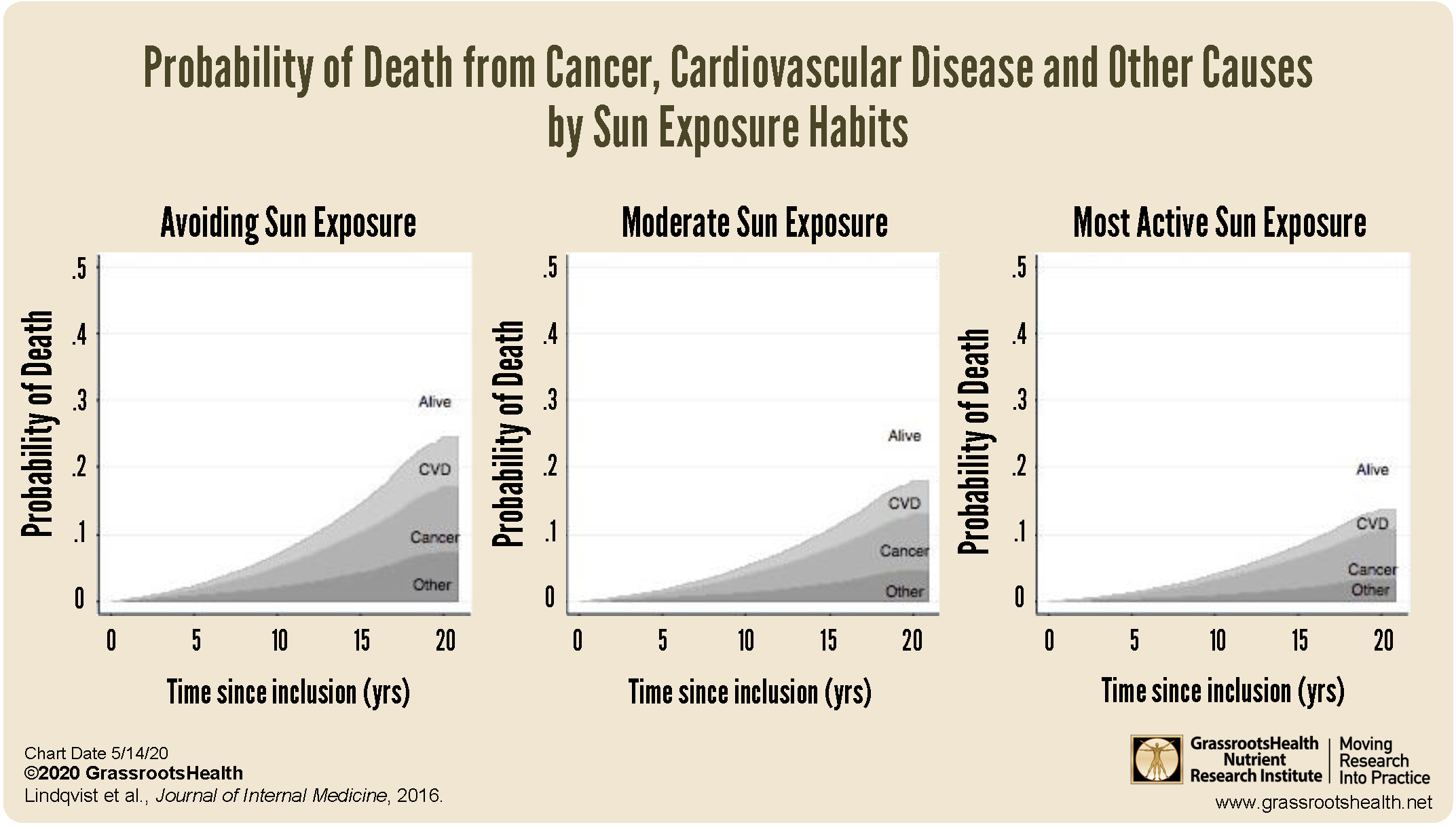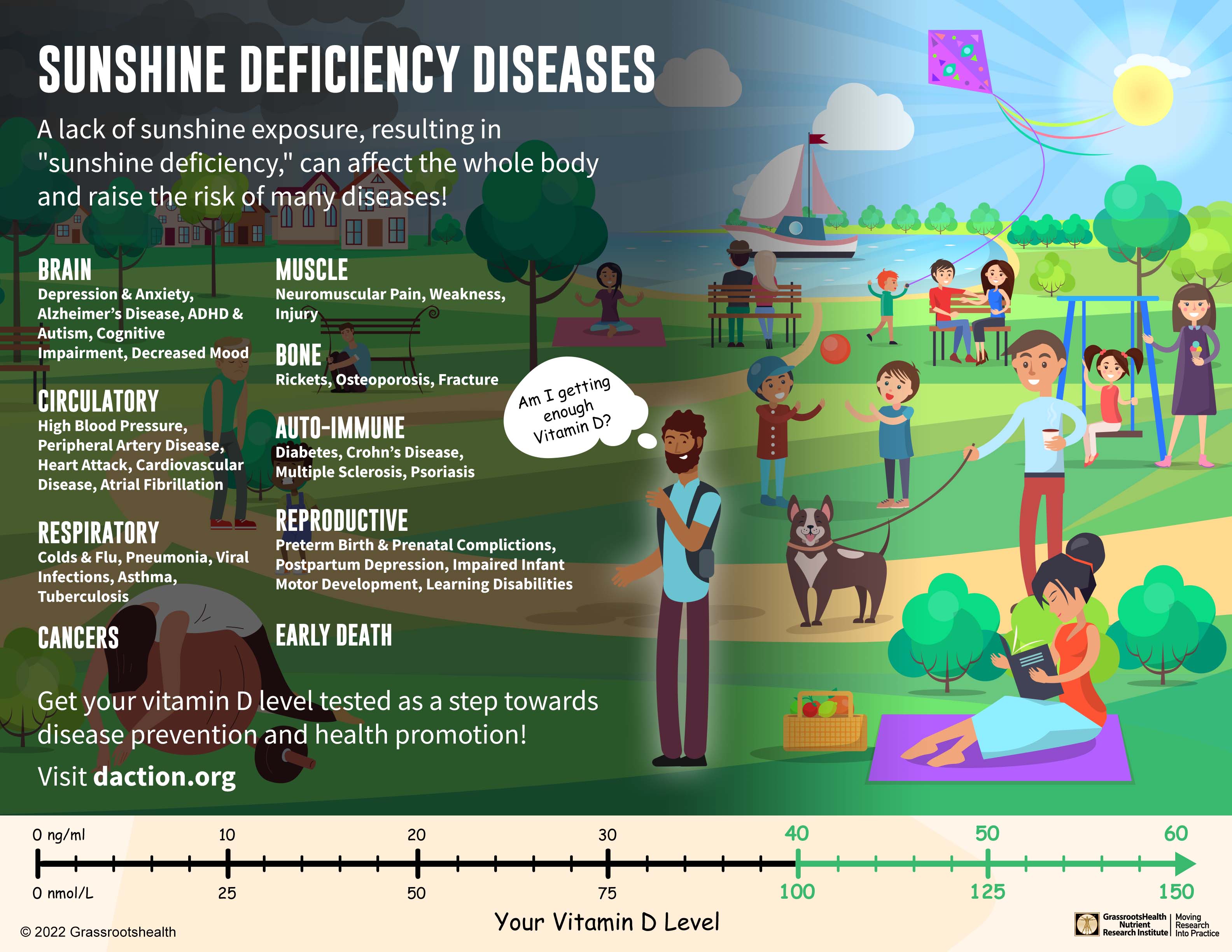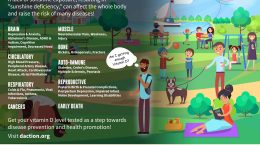Published on May 2, 2023
Studies show how more sunshine in your life can help you live healthier, longer, and that avoiding sunshine could be the 4th major lifestyle factor leading for an early death
Key Points
- Researchers discovered the mortality rate for women who avoided sun exposure was two times higher than those with the highest sun exposure, with an intermediate mortality rate in those with moderate sun exposure; those same researchers have determined that low amounts of sunshine exposure could be considered the 4th major lifestyle factor for health, after low exercise, smoking, and obesity
- There are consistent epidemiological data that mortality is highest among those people classified into the lowest group for serum 25(OH)D [vitamin D] or for sun exposure
- 340,000 deaths per year in the United States and 480,000 deaths per year in Europe, as well as a rise in many diseases, could be attributed to insufficient sun exposure or “sunshine deficiency, and the United States could expect to see a potential reduction of as much as 336,000 deaths per year and direct cost reductions upwards of $130 billion each year if everyone were to reach a vitamin D level of at least 40 ng/ml (100 nmol/L)
Are You Getting Enough Vitamin D? Check Now! Use code SUNMONTH23 for 10% off during May 2023.
 There is a growing amount of published research showing how sensible sunshine exposure can have a positive impact on health, can protect against disease, and can help people live healthier and longer. Because of this research, several organizations are pushing for updated sun exposure guidelines and an individualized approach to sunshine practices.
There is a growing amount of published research showing how sensible sunshine exposure can have a positive impact on health, can protect against disease, and can help people live healthier and longer. Because of this research, several organizations are pushing for updated sun exposure guidelines and an individualized approach to sunshine practices.
Yes – Sunshine Exposure Can Affect How Long You Live
In fact, the known health risks associated with lack of sun exposure and resulting low vitamin D levels are summarized by many, including Hoel and De Gruijl, who conclude that moderate UV exposure from the sun, without burning, is a health benefit and should be recommended as such.
One of the most impressive studies on sunshine exposure and health outcomes is by Lindqvist et al., who followed a group of 29,518 Swedish women to find that all-cause mortality was inversely related to sun exposure. When comparing sunshine and indoor tanning habits to specific health outcomes, including skin cancer incidence and mortality rates, they found that the mortality rate for women who avoided sun exposure was two times higher than those with the highest sun exposure, with an intermediate mortality rate in those with moderate sun exposure.
According to their findings, low amounts of sunshine exposure could be considered the 4th major lifestyle factor for health, after low exercise, smoking, and obesity. The chart below illustrates the higher probability of death among each group of women, based on their sun exposure habits.
Other key findings from publications by Lindqvist et al. include
- Women with active sun exposure habits had a lower risk of death from cardiovascular disease, cancer, and causes of death other than cancer or heart disease, such as diabetes, multiple sclerosis and pulmonary disease
- A 40% higher risk of cancer-related death was seen among women with low sun exposure vs the greatest sun exposure
- A 60% and 110% increased risk of non-cancer/non-cardiovascular disease related death was seen among women with moderate and low sun exposure habits compared to those with the highest sun exposure habits, respectively
- Women who developed melanoma but had more life-time sun exposure were more likely to survive, with mortality rates of 36% among the low sun exposure group, 16% for moderate sun exposure, and 13% for those with the greatest sun exposure
- Compared to women with the highest sun exposure, life expectancy for women who avoided sun was shorter by 0.6 to 2.1 years
They conclude,
“…low sun exposure is a risk factor for death in the same magnitude as smoking. In addition, as compared to those with the greatest sun exposure, woman with age > 55 and low sun exposure had 1 month shorter life expectancy, per year.”
How could sunshine exposure have such a profound effect on health and mortality?
“Sun exposure has additional effects apart from vitamin D production such as an effect on systemic inflammation, immunomodulation, melatonin system, nitric oxide, and calcium transport. In addition, low levels of sun exposure/vitamin D might also be a marker for an unhealthy lifestyle that precedes the diagnosis of T2DM.”
Sunshine’s Effects are Due to Vitamin D and Other Important Exposure-Induced Reactions
In a 2022 review, Dr. Reinhold Vieth states
“It is not plausible that human health can be optimal in the absence of exposure of skin to sunshine…”
In the review, he discusses how sunshine exposure induces mechanisms within the body that reduce the risk of many diseases and mortality, including the production of vitamin D and other substances. For example, sunlight on the skin causes vasodilation in the blood vessels and lowers blood pressure through at least three separate mechanisms:
- warmth causes vasodilation which lowers blood pressure
- nitric oxide is produced in the skin and released into circulation to cause vasodilation
- UVA leads to vasodilation, independent of the above
“There are consistent epidemiological data that mortality is highest among those people classified into the lowest group for serum 25(OH)D [vitamin D] or for sun exposure.”
Dr. Veith emphasizes the importance of getting enough vitamin D and its role in lowering disease risk and mortality. Levels seen on average among those living traditional lifestyles and obtaining their vitamin D through exposure to sunshine are around 40 ng/ml (100 nmol/L) which can be viewed as an indicator of both optimal sunshine exposure and ‘normal’ physiological levels of vitamin D.
A 2022 review by Grant and Boucher dives deep into the fluctuation of certain disease and mortality rates throughout the year. While UVA induced nitric oxide production and warmth from sunshine seem to play important roles, their research suggests that vitamin D levels resulting from sunshine exposure may be the primary driver of seasonal variations in disease incidence and mortality rates. The authors conclude,
“Hopefully, additional research can provide more information on the role of solar UVA and UVB in reducing the risks of seasonally variable diseases and mortality, leading to improved public health and clinical practice guidelines. Meanwhile, habitual increases in exposure to summer sunshine [with avoidance of sunburn] would also contribute to improving the public health.“
Sunshine Exposure Reduces the Risk of Many Diseases
A 2020 review of studies on the health effects of sunshine by Alfredsson et al. indicated that 340,000 deaths per year in the United States and 480,000 deaths per year in Europe, as well as a rise in many diseases, could be attributed to insufficient sun exposure or “sunshine deficiency.” These diseases include cancer (especially breast and colon cancer), hypertension, cardiovascular disease, metabolic syndrome, multiple sclerosis (MS), Alzheimer’s disease, autism, asthma, type 1 diabetes, and myopia, among others.
Additional research linking several health conditions to “sunshine deficiency” can be found here. The infographic below also illustrates some of the different diseases affected by a lack of sunshine and vitamin D.
Click to Download, Print & Share
The Cost of Avoiding Sunshine Exposure and Low Vitamin D
As Lindqvist et al. concluded, low amounts of sunshine exposure could be considered the 4th major lifestyle factor for health, after low exercise, smoking, and obesity. With vitamin D deficiency being the most obvious result of low sunshine exposure, raising serum vitamin D concentrations may be the most efficient and cost-effective way to reduce the chronic disease burden in the US and increase life expectancy caused by a lack of sun. Of the 30 leading causes of death in the US in 2010, 19 have been linked to low vitamin D status. If the US population were to increase their vitamin D levels to at least 40 ng/ml (100 nmol/L), we could expect to see a potential reduction of as much as 336,000 deaths per year and direct cost reductions upwards of $130 billion each year.
What are we waiting for? Help protect your overall health with sensible sun exposure and test to make sure your vitamin D level is in the recommended range of 40-60 ng/ml (100-150 nmol/L)!
Measuring Your Level is Important… Are You Getting Enough Vitamin D?
The only way to know is to test your levels! Testing versus blind supplementation is essential to know for sure if what you are taking is the right amount for you. Once you test your vitamin D (and other levels) to know where you are NOW, you can account for any upcoming changes in lifestyle over the coming months and adjust your intake to reach (or maintain) your targets.
- Vitamin D
- Magnesium PLUS Elements
- Omega-3 Fatty Acids
- hsCRP
- HbA1c
- TSH
- Type 1 Diabetes Autoantibodies
Did you know that each of the above can be measured at home using a simple blood spot test? As part of our ongoing research project, you can order your home blood spot test kit to get your levels, followed by education and steps to take to help you reach your optimal target levels. Start by enrolling and ordering your kit to measure each of the above important markers, and make sure you are getting enough of each to support better mood and wellbeing!
Create your custom home test kit today. Take steps to improve the status of each of these measurements to benefit your overall health. With measurement you can then determine how much is needed and steps to achieve your goals. You can also track your own intakes, symptoms and results to see what works best for YOU.
Enroll in D*action and Test Your Levels Today! Use code SUNMONTH23 for 10% off during May 2023.








